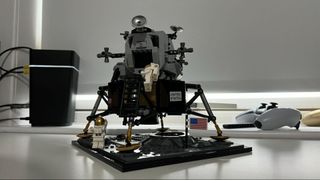Space Verdict
This is a great display set for the kind of person that only buys one or two Lego sets every once in a while, but for hardcore collectors it’s a bit disappointing. The build is interesting enough and there are some unique Lego pieces used, but the overall stability of the Lander is a bit flimsy.
Pros
- +
Nice display piece
- +
Two minifigures
- +
Some rare Lego pieces
Cons
- -
Flimsy
- -
Feels incomplete without another NASA set
Why you can trust Space.com
Price: $99.99/£89.99
Model number: 10266
Pieces: 1,087
Finished item dimensions: 7 x 8 x 7 inches / 20 x 22 x 20 cm
Recommended age: 16+
There are so many things in the history of space travel that can make a great Lego set. When you think about the wonders of engineering that have taken man off this planet and deep into the cosmos, it’s little wonder that we’ve inspired so many feats of small-scale engineering with Lego. Space and Lego also go almost as far back as the Lego brick itself, with one of the first real themes of the modern era being Space, as memorably highlighted in The Lego Movie’s Benny the Astronaut.
That’s not to mention the galaxies of fantasy-space vehicles, planets, and more that have been represented in brick form, but it’s in the Lego NASA line that the company has traditionally struck a great balance between sets that are great for a shelf, and great to build. Unfortunately for the Lego NASA Apollo 11 Lunar Lander, it leaves us wanting more. While the final product looks great and it includes some unique minifigure pieces that you’ll struggle to find anywhere else, there’s an uneasy flimsiness during the build and a small display stand that makes the set fail to reach its potential.
It’s not a difficult build, nor is it a particularly long one, but as a Christmas present for someone that’s not bought a Lego set in years, or someone who really likes space, it’s a good fit. Just don’t buy it for any space-mad children or it’ll crash back down to orbit soon enough.
If you’re really desperate for something to show off your predilection for outer space, then our best Lego space deals have you covered.
Lego NASA Apollo 11 Lunar Lander: Build

The NASA Apollo 11 Lunar Lander begins by building the display stand, which takes the form of a small chunk of the Moon. This is nicely textured, with the use of the various directional Lego blocks as well as smooth tiles really conveying the surface of the Moon well in Lego form. We really do wish it was bigger, however, as the Lander ends up covering practically all of it. This eliminated any chance it had as a playset and made posing the two astronaut minifigures somewhat difficult.
The main body of the Lander is made up of symmetrical brick patterns which are then held together by some Lego Technic pieces. This is a good combination of the traditional Lego building style and the more sturdy Technic, but it feels like it needs more. We were genuinely convinced a few times when building it that the whole thing was going to crumble in our hands.

If you want to watch along with a build of the Lego NASA Apollo 11 Lunar Lander, check out the video below which shows Tariq Malik, our intrepid Editor-in-Chief, building the Lego kit along with his daughter, Zadie.
Lego NASA Apollo 11 Lunar Lander: Design
Overall, the Lego NASA Apollo 11 Lunar Lander looks great. It’s very evocative of the real thing, which is helped by the choice to use a lot of smooth pieces, along with Lego Technic pieces. Smartly, the design largely hides Lego studs when it can, which we think was an intentional move to give the set more of a statue or display look. The small Lego people floating around the Lander destroy the illusion a bit, but the set does a great job at making the Lander look sufficiently mechanical.
Gold, which is a fairly uncommon color in Lego, is also used well in this set. The visors on the helmets of the astronauts are gold, as are the feet of the Lunar Lander and some of the detailing on the main body. We’d have loved the large golden stickers to be replaced with actual bricks, but thankfully there are only a handful, and you do actually get a rather large amount of gold tiles with the set.

We think that the Lunar Lander set would have benefitted from having a larger display base, and potentially incorporating a few more colors. As it stands, it’s a bit cramped, making the iconic American flag detailing element a bit of an afterthought. It feels like the base plate should be around double the size in order to give the piece the correct room to breathe, but it’s sufficient as it is. We imagine that in a modern version of this set, something like this would have been incorporated. An advantage of the smaller base is that it’s a set that’s pretty easy to fit on any bookshelf, with the small footprint of the Lunar Lander making it an ideal display piece.
Should you buy the Lego NASA Apollo 11 Lunar Lander?
Maybe.
We wouldn’t necessarily recommend the Lego NASA Apollo 11 Lunar Lander to big Lego fans, but for fans of space, or as a display place on a desk, it’s definitely worth considering. It’s not going to challenge anyone who’s built some sets before, but for a casual fan of Lego, or for someone that’s not purchased a set in years, it’s an enjoyable, if simple build.
We really dislike how flimsy the set feels towards the end of the build, especially when it seemed like structural integrity was going to be a focus of the build with the Technic pieces. However, if you take your time and are used to building Lego, it shouldn’t be too much of a problem.
The minifigures do look great and use parts that are difficult to get a hold of now that this set is reaching the end of its shelf-life. So if you can find it for slightly cheaper than retail price, it may be worth picking up. In our honest opinion though, we’d probably recommend you go with another set in the NASA line instead.
Other Lego NASA sets to consider
If you’re keen to expand your Lego NASA collection, there’s a huge amount to choose from. One of our favorites is the Lego NASA Space Shuttle Discovery which is an impressive replica of the legendary ship. It’s a fun build, although it’s very much a display piece. This is emphasized by the fact that it doesn’t come with any minifigures, so your Gravity role-play sessions won’t be possible without a custom George Clooney minifigure, unfortunately.
The Lego NASA Apollo Saturn V is another hugely impressive set, if you’ve got the room to display it. Standing at almost 40 inches (1 meter) high, it’s one of the tallest sets Lego have ever released. It’s a bit of a repetitive build, but the attention to detail and great part-per-piece price ratio make it a strong recommendation from us.
If a galaxy far far away is more your speed, then we have a huge number of the best Lego Star Wars sets reviews for you to check out. From the incredible Mos Eisley Cantina, which is one of the most impressive Star Wars playsets ever, to the iconic Lego Star Wars Millennium Falcon, there’s something for every Star Wars fan. Especially those that are… less than responsible with their money.
Join our Space Forums to keep talking space on the latest missions, night sky and more! And if you have a news tip, correction or comment, let us know at: community@space.com.
Jordan Middler is a Scottish journalist with a love for anything he can put on a shelf. With almost a decade of creating content about video games and tech, as well as five years as the chief voice of gaming for BBC Scotland, Jordan has recently turned his attention to all things LEGO, mainly so that when we reach the heat-death of the universe, he can build himself a lovely fallout shelter and wait for it to all blow over. If he’s not reviewing the latest games, or building LEGO, you’ll find him dusting his shelves in the eternal war with his greatest enemy, dust.


